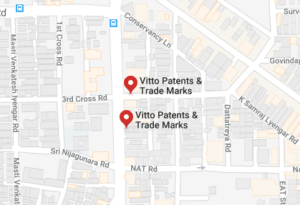PATENTS
GENERAL INFORMATION
Patent, under the Act is grant from the Government to the Inventor for a limited period of time, the exclusive right to make, use, exercise and vend his Invention. Thus, by this grant, the Inventor becomes a Patentee, giving him substantial right over the said Invention, which he can use it for himself or convey it to others, for a monetary consideration. The right that he enjoys over the said Invention is for a specific period of 20 years from the date of Application, provided the patentee renews the same, to keep the patent in force. After the expiry of the said period, the invention can be put to use by any person other than the person for whom the patent has been granted. Thus, the Patent Law recognises the exclusive right of a patentee to gain commercial advantage out of his invention, for a specific period of 20 years. To be patentable, the invention must be new and useful. It also must be non-obvious to a person possessed of average skill in the art and more importantly the Inventor has to prove that it contains an “inventive step”.
PATENT REGISTRATION PROCESS
Steps involved are as follows:
Step 1 – The first step towards filing a patent is drafting of a Patent Specification. A Patent specification is a document through which an inventor discloses the details of his invention to the patent office or the public. A Patent Specification must be technically and legally right, for it to be accepted by the Patent Office. The claims in the complete specification is the essence of the Invention, which determines the rights of a patentee.There are two types of patent specifications:
- Provisional Specification
Provisional specification is a document which broadly, not completely, discloses an inventive concept. Provisional specification is filed mainly to secure a “priority date” when inventor needs more time to work out the details of his invention. Complete information of the invention is to be mentioned in this specification at the time of filing because it will be used at a later stage to determine whether complete specification claims the invention that forms part of Complete Specification.
- Complete Specification
Complete Specification is a document which discloses all the details of the invention in a clear and complete manner. This document is different from provisional specification because it must have an abstract and concludes with a claim or a set of claims. Once the Patent Specification is drafted, a patent application can be filed, which is the next step.
Step 2 – Filing a patent application in the Indian Patent Office is the second step towards securing a patent for your invention in India. To file a patent application, a set of forms has to be submitted to the patent office:
- Form 1 (Application for Grant of Patent)
- Form 2 (Provisional Complete / Specification)
- Form 3 (Statement and Undertaking under Section 8)
- Form 5 (Declaration of Inventorship)
- Form 9 (Request for Publication)
- Form 18 (Request for Examination of Application for Patent)
A Patent application can be filed in two ways :
- Subsequent filing
In subsequent filing, complete specification is filed subsequent to the filing of corresponding provisional specification and further claiming priority from the corresponding provisional specification. Subsequent filing of complete specification is done within twelve months from the “priority date” or filing date of provisional specification.
- Direct filing
In direct filing, no corresponding provisional specification is present and complete specification is filed directly at the patent office.
Step 3 – The Application for Patent would be published ordinarily within one month from the date of request on Form 9. The applicant shall have provisional rights from the date of publication.
Step 4 – After publication, the process of examination starts wherein the Patent Office will issue the First Examination Report (FER). The Applicant must respond to the objections (if any) raised by the Examiner and place the application in order for grant within 6 months from the date of issue of the FER.
Step 5 – When all the requirements are met, the patent is granted, after 6 months from the date of publication, entry is made in the register of patents and it is notified in the Patent Office Journal.
Step 6 – The patent application can be opposed before and after grant of the patent. Patent can also be revoked under some circumstances.
Step 7 – After grant of the patent, renewal fees have to be paid to keep the patent in force.
INTERNATIONAL PATENT REGISTRATION
International patent regime and international instruments helps to obtain patent in multiple countries. Important instruments are as follows :
- Paris Convention
- Patent Cooperation Treaty (PCT)
Paris Convention:
Paris Convention for the protection of Industrial Property, was one of the first instruments to bring harmony between patent regimes of various jurisdictions.
The substantive provision of the convention fall into three main categories:
- National Treatment
- Right of Priority
- Common Rules
Patent Cooperation Treaty (PCT)
Before PCT if an applicant wanted to file a patent application in multiple countries it had to be done by filing the application physically in those countries and only available to the applicant was the right to claim priority. While filing through PCT, the applicant can designate countries where he wishes to apply for patent protection. PCT application procedure consists of two phases ie.International phase where once a PCT application is filed, an International Search Report is generated by the International Searching Authority and National phase where national applications are filed corresponding to International PCT application.
Steps for Patent Registration through PCT
Step 1 – Filing of international application in a Receiving Office (RO)
Nationals/Residents of India can file an international application with – the Indian Patent Office at Delhi, Chennai, Mumbai or Kolkata as the Receiving Office (RO/IN) or – the International Bureau of WIPO as the Receiving Office (RO/IB). A Request (Form PCT/RO/101) accompanied by description, claims, abstract (and drawings if required) of the invention is to be submitted in triplicate. The Receiving Office India (RO/IN) accords as the international filing date the date of receipt of the international application, after the following checks:
- The applicant is a resident/national of India
- The international application is in English or Hindi
- The international application contains at least the following elements:
- An indication that it is intended as an international application
- The designation of at least one Contracting State
- The name of the applicant, as prescribed
- A part which on the face of it appears to be a description
- A part which on the face of it appears to be a claim or claims.
The International Filing Date is considered to be the actual filing date in each country designated in the Request. The RO keeps one copy of international application for record named ‘Home Copy’. The RO sends one copy of international application to International Bureau (IB) of WIPO named ‘Record Copy’. The RO sends one copy of international application to the International Searching Authority (ISA) named the ‘Search Copy’.
Step 2 – International Search by an International Searching Authority (ISA)
The International Searching Authority (ISA) establishes International Search Report (ISR) which identifies the published patent documents and technical literature (“prior art”) which may have an influence on whether the invention is patentable. The ISA also establishes Written Opinion of Search Authority (WOSA) on the invention’s potential patentability. The international application along with International Search Report is published by WIPO after expiry of 18 months from the priority date of the application.
Step 3 – International Preliminary Examination by an International Preliminary Examining Authority (IPEA)
After establishment of ISR/WOSA and publication by WIPO, the applicant may opt for International Preliminary Examination (IPE). The International Preliminary Examination Authority (IPEA) establishes International Preliminary Report on Patentability (IPRP) (Chapter II of the Patent Cooperation Treaty). If the applicant does not opt for IPE, the International Bureau of WIPO publishes the WOSA as International Preliminary Report on Patentability (Chapter I of the Patent Cooperation Treaty). It is to be noted that this is an optional phase.Residents/Nationals of India can file a Demand (Form PCT/IPEA/401) for international preliminary examination in the Delhi branch of the Indian Patent Office which acts as IPEA/IN. The IPEA carries out an additional patentability analysis and sends Written Opinion(s) to Applicant. The Applicant may make amendments to international application. The IPEA establishes International Preliminary Report on Patentability (IPRP)(Chapter II of PCT).
Step 4 – National Phase
After the end of the PCT procedure, either after international search or after international preliminary examination and before 30/31 months from the priority date, applications for the grant of patents can be filed before the national (or regional) patent offices of the countries in which patent protection is desired. The filing procedure, fee and processing are as per the requirements of national law relating to patents in each country. The filing date is the international filing date in all such countries



